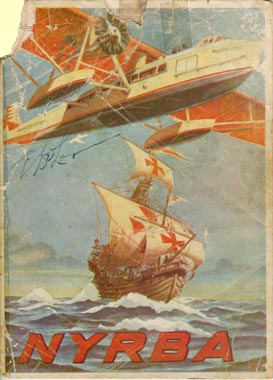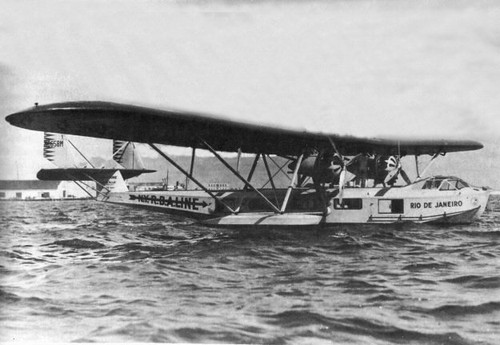 It was a short-lived, but really interesting international airline. The New York, Rio, and Buenos Aires Line, commonly called the NYRBA Line, was the brainchild of Ralph A. O’Neill, an American World War I flyer and aviation promoter. While serving as an advisor to the Mexican Air Force between 1920 and 1925 O’Neill perceived the tremendous potential of commercial aviation along South America’s eastern coast. A continent starved for rail and road transportation, O’Neill understood that the movement of people and goods by air would greatly aid in the development of modern commerce in the region.
It was a short-lived, but really interesting international airline. The New York, Rio, and Buenos Aires Line, commonly called the NYRBA Line, was the brainchild of Ralph A. O’Neill, an American World War I flyer and aviation promoter. While serving as an advisor to the Mexican Air Force between 1920 and 1925 O’Neill perceived the tremendous potential of commercial aviation along South America’s eastern coast. A continent starved for rail and road transportation, O’Neill understood that the movement of people and goods by air would greatly aid in the development of modern commerce in the region.
To survey the area more thoroughly, O’Neill obtained a contract to sell Boeing aircraft in South America in 1928. Although the sales effort was a bust, O’Neill succeeded in laying the groundwork for an airline that would operate between New York, down the eastern coasts of North and South America to Buenos Aires, Argentina. His plans called for transportation between the two terminals of the line within one week. He found a firm supporter for his airline plans in Robert Wood Bliss, American Ambassador to Argentina, who looked upon the effort as a means of more firmly building cordial relations between the United States and Latin America.
Based upon his initial efforts, O’Neill returned to New York during the winter of 1928‑1929 and recruited investment capital for the proposed NYRBA Line. The primary investor was James H. Rand Jr., chief executive officer of the Remington‑Rand Corporation, but several others, among them Reuben Fleet of Consolidated Aircraft Corporation, also invested heavily. The NYRBA Line was formally incorporated on 17 March 1929.
 In July O’Neill and several others made a trailblazing flight along the proposed route of the line in a Sikorsky S‑38 seaplane to establish formal contacts, excite public interest, and develop government support. Since the new line planned to base its operations on 14 of Consolidated Aircraft Corporation’s “Commodore” seaplanes, O’Neill took special care to obtain landing and dock space in each city’s harbor.
In July O’Neill and several others made a trailblazing flight along the proposed route of the line in a Sikorsky S‑38 seaplane to establish formal contacts, excite public interest, and develop government support. Since the new line planned to base its operations on 14 of Consolidated Aircraft Corporation’s “Commodore” seaplanes, O’Neill took special care to obtain landing and dock space in each city’s harbor.
The company began scheduled operations on 21 August 1929 between Buenos Aires and Montevideo, Uruguay. On 1 September the line added the Buenos Aires‑Santiago, Chile, scheduled route. The line established a subsidiary, NYRBA do Brazil, to operate air service within Brazil on 22 October 1929. O’Neill had promised to begin scheduled service between New York and Buenos Aires within a year of incorporation, and to make good on 19 February 1929 he began the first flight from Buenos Aires, arriving in the United States six days later.
 From the very beginning, Juan Trippe, head of the Aviation Corporation of the Americas which held Pan American Airways, had wanted to forestall the competition in Latin America that the NYRBA Line promised. Every step forward to O’Neill’s line brought an increased effort from Trippe to force NYRBA into receivership. In a business without many rules, Trippe redefined the term “pressure” for NYRBA.
From the very beginning, Juan Trippe, head of the Aviation Corporation of the Americas which held Pan American Airways, had wanted to forestall the competition in Latin America that the NYRBA Line promised. Every step forward to O’Neill’s line brought an increased effort from Trippe to force NYRBA into receivership. In a business without many rules, Trippe redefined the term “pressure” for NYRBA.
Tripp’s influence with the United States Postal Service was especially important as it ensured that the line did not receive critical airmail contracts which would have meant solvency. When Postmaster General Walter Folger Brown made it clear that he would award no airmail contracts in the region to any company other than Pan American, NYRBA’s days were numbered. On 19 August 1930 James Rand agreed to sell out to Pan American for $2 million, about $3 million less than the initial capitalization of the company a year and a half earlier. On 15 September Trippe formally acquired the assets of NYRBA and what had been the world’s longest airline ceased to exist. Pan American picked up its schedule and used its “Commodore” aircraft to fly the routes between Buenos Aires and Miami.


Roger:
Very nice story – and great graphics too. You might want to read a little more about Ralph O’Neill and his dream here:
http://www.panam.org/points-of-departure/stories/203-commodore-ralph-o-neill-s-magic-carpet.html
LikeLike
Read O’Neill’s book A DREAM OF EAGLES!
LikeLike
Yes, I have. Excellent book.
LikeLike
Pingback: Clichê de propaganda corrobora hipótese do BF sobre CLIPPERS | F A U ─ U F P A
Hello, also read ‘Pilot of Fortune’ by Frank H Jerdone.
LikeLike
My dad, Nat Browne, flew Fort Tri-motors over the Andes between Buenos Aires and Santiago for NYRBA Lines. He was NYRBA’s chief pilot for South America until the Pan Am takeover in 1930.
LikeLike